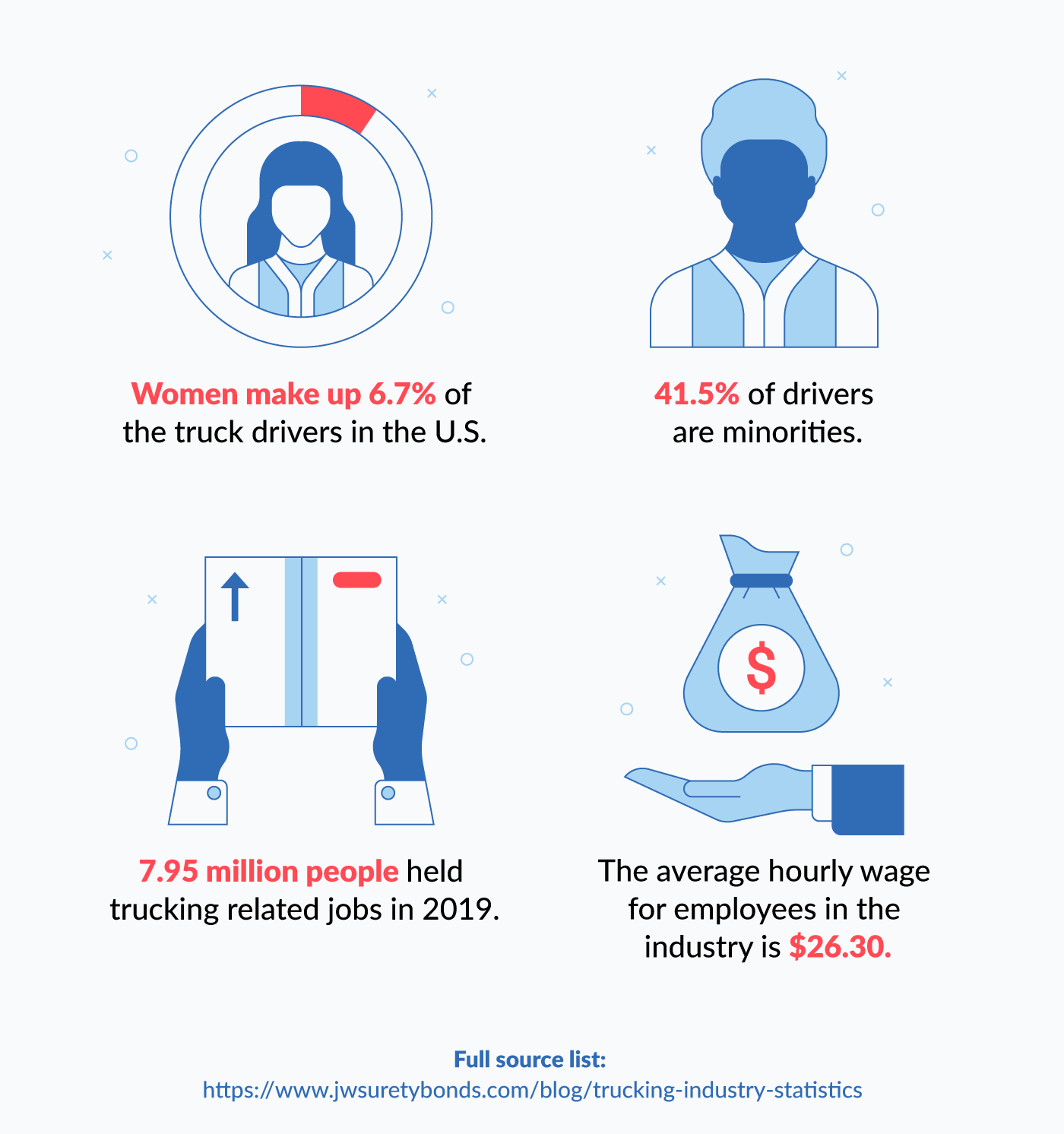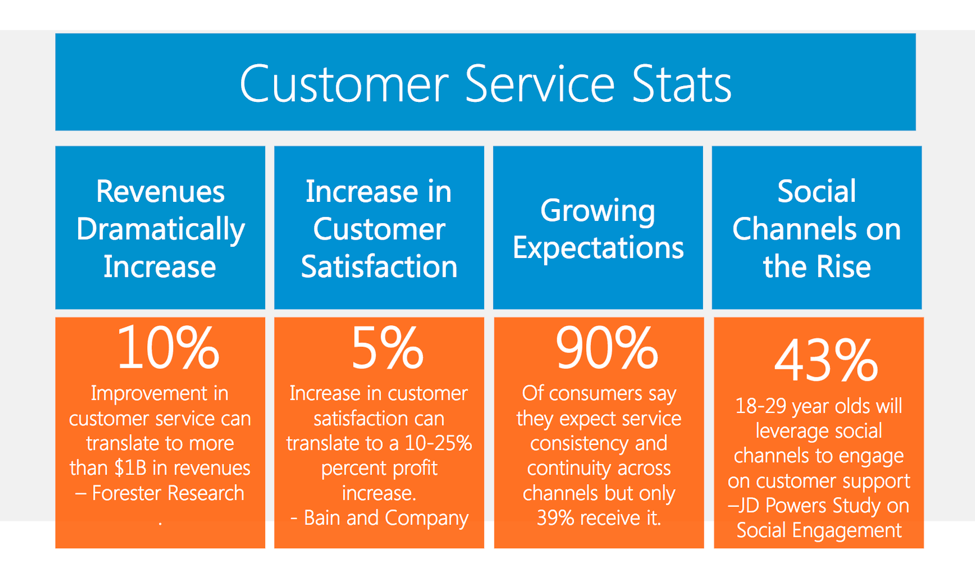The U.S. trucking industry earned $417.4 million in 2023 and is still growing. With demand for truck drivers on the rise, truck driving schools have become big business.

With over half a million truck driving jobs needing to be filled, the career opportunities seem boundless for new and upcoming truck drivers. This major gap between supply and demand for truck drivers puts truck driving schools in the perfect position to capitalize.
This guide will walk you through how to start a truck driving school. Topics include market research, competitive analysis, registering an EIN, obtaining business insurance, forming a legal business entity, and more.
1. Conduct Truck Driving School Market Research
The trucking industry is facing a growing shortage of qualified drivers. With demand far outpacing supply, truck-driving schools have a massive opportunity to fill this gap while running a profitable business. Thorough market research is key to assessing the feasibility of a truck driving school in your area.

There are currently 15,000+ truck driving schools and training programs in the US. The commercial truck driving training industry brings in $4.4 billion in revenue annually nationwide. With the shortage of drivers estimated to reach over 100,000 by 2023, there is ample room in the market for new entrants.
When conducting research, determine the current number of accredited truck driving schools in your state and locality. Seek out statistics on the local demand for truck drivers in your area. Review job boards and speak with transport companies to validate the shortage, as demand varies by region. Identify where the greatest shortfalls exist.
Also, assess projected growth for trucking and logistics in your area using data from state agencies and industry groups like the American Trucking Association. With truck tonnage forecasts expected to grow nationally, strong demand is likely to persist. Evaluate how COVID-19 impacts created new demand dynamics locally.
Examine state regulations for commercial truck driving schools. Consider bonding requirements, facility specifications, instructor licensing rules, and CDL testing site protocols which vary by state. Develop estimates for licensing, insurance, training vehicles, and other costs to accurately forecast your total startup investment.
Conducting thorough market research will allow you to realistically assess the profit potential of opening a truck driving school in your specific area. It will also help avoid unnecessary risks or wasted efforts if the local demand dynamics don’t support a new entrant at this time.
2. Analyze the Competition
Carefully evaluating your competition is crucial when starting a truck or car driving school. This gives key insights into discouraging factors and opportunities to differentiate.
Begin by identifying existing accredited trucking schools within a 50-100 mile radius. Search state licensing databases and industry associations to compile a list. Consider broadening geographically if planning an online program.
Visit competitor websites and collect data on services offered, class formats, duration, and pricing. Make note of unique offerings like job placement programs and financial assistance. Gauge the professionalism of their online presence and marketing.
Search online reviews and feedback for each school. Look for recurring complaints around facilities, instructors, aged truck fleets, hidden fees, or issues getting licensed after graduation. Read between the lines to spot their weaknesses.
Drive by competitor locations to assess their facilities. Estimate their capacity in terms of trucks, classrooms, and yard space. See if they operate additional training lots.
Search traffic and lead data for competitor websites using SimilarWeb and SEMrush. Determine their visibility, credibility, and share of voice online. See where gaps exist to win more leads in the market.
Analyzing the competition gives tremendous input for positioning your truck driving school. Learn from their weaknesses and emulate their strengths. Use the intel to optimize your offerings, transparent pricing, a modern truck fleet, and stellar customer service from the start.
3. Costs to Start a Truck Driving School Business
Starting a truck driving school entails considerable upfront investment. Costs ramp up quickly due to specialized equipment needs, licensing, and facilities. Understanding these expenses is vital for proper planning and funding.
Startup Costs
- New commercial tractor-trailer tractor-trailers range from $150k-$225k. Buying 5 used ones in good condition would likely cost $400k-$700k.
- Monthly lease costs for 5 trucks would be approx $20k. Consider a mix of newer and older rigs to contain costs yet offer modern driver experiences.
- Leasing warehouse space for classrooms would run $8-$15 per sq ft monthly.
- Incorporating the business, licensing, insurance fees and legal retainers could cost $15k or more to start.
- Outfitting office space and classrooms represents another $25k-$100k depending on whether buying new or used furniture and tech.
- Bringing on 4-5 instructors at $50k salaries each would require $200k+ annually.
- Support staff like office administrators and CDL test proctors add another $100k to the payroll.
All said the minimum startup costs for a properly equipped truck driving school with staff and facility would likely fall between $750k-$1.5 million. Sufficient operating capital must be secured to keep the business running smoothly as student volumes ramp.
Ongoing Costs
Ongoing expenses stay elevated month to month. Some ongoing costs you’ll encounter include:
- Loan payments
- Truck leases
- Rent
- Overheads like insurance premiums
- Maintenance
- Tech platforms
- Marketing initiatives
Of course, payroll persists as the top regular outlay. Starting a truck driving school brings major startup and operating costs. But with careful planning, the investments pay dividends over time by meeting unmet driver demand.
4. Form a Legal Business Entity
When starting a truck driving school, the legal structure carrying the most protections is a limited liability company (LLC). LLCs limit personal liability if sued while allowing pass-through taxes. This balances risk management with operational simplicity.
Sole Proprietorship
Sole proprietorships offer ease of setup but no liability safeguards. All lawsuits and debts are the sole responsibility of the business owner. For truck schools, accidents could quickly surpass insurance limits and threaten personal assets.
Partnership
Partnerships allow multiple owners to combine assets and expertise. However, liability risk also transfers across all partners. Disagreements can also compromise operations or lead to deadlocked decision-making.
Corporation
Corporations provide the highest level of owner protection under the law. However, the extensive corporate paperwork, board oversight, and double taxation often prove needlessly burdensome for small truck schools.
Limited Liability Company (LLC)
LLCs provide the best of all worlds – personal asset protection, pass-through taxation, flexible management, and continuous existence if owners depart. Single-member LLCs are simplest initially then easily expanded for partners or investors later.
It takes just three key steps to establish an LLC:
- Name your business
- Register your LLC with the state
- Create an operating agreement
Visit your state’s business services website to register the LLC directly. LegalZoom also streamlines registration document preparation if assistance is helpful. Take the time upfront to start your trucking school the right way.
5. Register Your Business For Taxes
An Employer Identification Number (EIN) serves as a business’s tax ID number with the IRS. All LLCs and corporations must obtain one shortly after forming their legal entity.
Applying is fast, free, and can be completed entirely online via the IRS EIN Assistant tool.
Follow these simple steps to get your EIN:
- Gather ownership documents like LLC Certificate of Formation to support EIN application
- Access EIN Assistant and select view application as a business type (ex: LLC)
- Work through a short Q&A confirming entity details
- Provide owner information including SSN which serves as an identifier moving forward
- A print confirmation page with assigned EIN
The whole process takes less than 15 minutes. With EIN established, use it wisely when opening financial business accounts, applying for licenses, and permitting.
State tax compliance is equally crucial. As a trucking school, sales tax accounts must be set up to remit owed amounts. State registration around payroll/income tax withholding is also required if hiring employees.
Use your home state’s business tax portal to:
-Apply for sales tax ID
-Register for income tax withholdings
Compatible accounting software should also be implemented from the start to accurately track tax liabilities across state, local, and federal agencies. Consulting a tax professional can help establish best practices as operations grow. Staying current and compliant with business tax reporting protects your new truck driving school.
6. Setup Your Accounting
Proper accounting is crucial for truck driving schools right from the start. Detailed financial tracking provides real-time visibility into profitability and cash flow to guide decisions. It also satisfies IRS requirements come tax time.
Open a Business Bank Account
Begin by establishing dedicated business bank accounts and credit cards. Never co-mingle personal and company funds. Apply for company cards in the LLC name using your EIN. Limits up to $100k are common depending on revenues and credit profile.
Accounting Software
QuickBooks accounting software ties everything together automatically by integrating accounts. Connect bank/CC data flows to categorize income and expenses correctly. This level of automation proves invaluable as operations grow. Detailed reporting also simplifies year-end tax preparation.
Hire an Accountant
Supplementing Quickbooks with an accountant offers additional oversight for truck school finances. Utilize their services monthly for tasks like:
- Accounts reconciliation
- Payroll/Sales tax payments
- Financial statement generation
- Identifying growth opportunities
This may cost $500 – $1000 monthly but adds tremendous value for financial integrity and operational optimization.
7. Obtain Licenses and Permits
Proper licensing is mandatory for opening a truck driving school to comply with federal and state regulations. Find federal license information through the U.S. Small Business Administration. The SBA also offers a local search tool for state and city requirements.
At the federal level, new trucking schools must register as Career Schools or Training Programs with the Federal Motor Carrier Safety Administration (FMCSA). This oversight ensures your CDL training curriculum and instructor credentials meet industry standards.
FMCSA registration involves submitting extensive documentation. This includes details on instructor licenses for trucking companies, training/testing certificates, classroom instruction and syllabi, and score sheets. It also offers information on commercial driver’s license requirements.
School facilities and equipment undergo inspections as well. Allow 6+ weeks for the initial processing and documentation review.
State-level licensing must also be completed through departments like the College Licensing Division. Documents reviewed include facility diagrams denoting room usage, fire and safety plans, Certificate of Occupancy, and Board of Health inspection sign-off.
These agencies govern school operational codes for items like classroom capacity limits, commercial truck testing routes, and required equipment such as eye-wash stations.
Local municipal permits relate more to property usage allowances and zoning. Common certificates required are the Land Usage Permit, Utility Connection Permit, and Building Permit.
Finally, register with your state DMV/RMV for the ability to administer the CDL license exam onsite after the students complete training.
8. Get Business Insurance
Operating a truck driving school without proper insurance exposes the business to major financial perils. Accidents, lawsuits, and property damage could quickly bankrupt the LLC if uncovered.
Consider these risk scenarios:
- A student crashes a training tractor trailer causing severe injuries to others. Medical and legal claims quickly exceed $1 million. Without ample liability coverage, the truck school assets could be seized.
- An electrical fire breaks out overnight in the classroom building. No commercial property insurance leaves repairs and rebuilding to be fully self-funded.
- A diesel spill from a fill-up seeps into groundwater near the lot. Environmental cleanup runs $300k without environmental liability coverage.
Top-notch business insurance is essential from day one. Packages often bundle:
- General Liability: Covers 3rd party bodily injury and property damage claims
- Commercial Auto: Covers liability and collision claims on business vehicles
- Umbrella: Additional liability coverage above underlying policy limits
- Property: Covers damage to school-owned buildings and assets
- Workers Compensation: Covers employee injuries occurring on the job
Independent agents access multiple carriers to optimize coverage and pricing. Expect to provide details on all school assets, locations, staff levels, and more. Quotes for a robust truck school policy would likely start around $150k annually. Budget higher limits for schools with larger fleets and staff counts.
9. Create an Office Space
Establishing a professional business office lends credibility to your truck driving school while handling administrative tasks. An office also provides an address for legal and licensing paperwork versus using your home.
Home Office
For many new trucking schools, working from a home office offers the most convenient and affordable option. Expect costs less than $100 per month for basic utilities and supplies once furniture and computers are in place. However, home offices lack interactions for strategic growth planning.
Coworking Office
Coworking spaces provide more visibility plus networking with other small business owners for under $500 monthly. Shared amenities reduce overhead for things like internet, printers, and meeting rooms while enabling focus time away from home. WeWork locations also host workshops and social events for community building.
Commercial Office
As operations grow, stand-alone commercial office rentals become the end target to completely isolate the professional and personal worlds. Expect lease rates around $20-$30 per sq foot in addition to utility and tax costs. Buildout and furnishings also add $15k or more upfront.
10. Source Your Equipment
A quality fleet sits at the core of every reputable truck driving school. Choosing between buying or leasing new versus used trucks merits careful cost/benefit analysis. Additional equipment like simulators and safety gear require sourcing as well.
Buy New
Purchasing new tractors provides the most modern, reliable options for students to train on. Major OEMs like Volvo and Freightliner deal directly for bulk purchases, typically at 10-20% discounts off MSRP. Custom spec learning-focused cabins equipped with cameras, mirrors, and dual brake pedals for under $150k.
Buy Used
Buying used saves substantially upfront, with good condition 5-year-old models averaging around $60k. Rigs with 500k+ miles often require more maintenance and downtime. Check CarFax reports before purchasing used inventory. Cast a wide net checking deals on Cars, Craigslist, and commercial truck sites.
Lease or Rent
Leasing helps contain steep equipment costs in the early years for new schools. Penske and Ryder Fleet offer attractive monthly tractor rental rates around $1500-2000. However, mileage caps and road restrictions may apply. Shop multiple vendors to negotiate the best terms.
Rentals prove cost-efficient when expanding class capacity for short periods. Daily tractor rates range from $150-300 depending on features. Great for specialized courses or overflow demand.
11. Establish Your Brand Assets
Crafting a distinctive brand identity helps truck-driving schools attract more students in competitive markets. Investing in core brand assets professionalizes public perception while streamlining marketing.
Business Phone Number
Start by securing a dedicated business phone line using a leading VoIP provider like RingCentral. Cloud-based systems enable calls, texts, faxes, and voicemails across devices for $30+ monthly. Centralize communications under a permanent number listed online and on all materials.
Design a Logo
Design a sleek, memorable logo that encapsulates your mission. Combine imagery like a big rig with school branding elements. Modern, minimalist styles forged by graphic design tools like Looka prove appealing across digital and print uses.
Print Business Cards
Business cards serve as mini ads to impress prospective students and partners. Include essential contact info, web address, and logo on cards ordered via convenient services like Vistaprint. Carry cards to trade at local hiring fairs and meetups.
Get a Domain Name
Domain names using targeted keywords help drive organic visibility. Secure and assume control of associated social media handles. Services like Namecheap facilitate access to popular extensions like .com at just $12 annually.
Design a Website
Build out an info-packed website on platforms like Wix without any coding. Striking themes and dedicated CDL training program pages communicate offerings online 24/7. Alternatively, hire web developers on freelance networks such as Fiverr to custom craft sites.
12. Join Associations and Groups
Plugging into local and national associations and peer groups lends tremendous upside for new trucking schools. Connections and insights from these communities accelerate growth through shared wisdom.
Local Associations
Research groups like the Commercial Vehicle Training Association (CVTA) offer accreditation programs, instructor training, and annual conferences for connecting with industry leaders. State trucking associations also provide regulatory advocacy, marketing exposure, and recruiting assistance.
Local Meetups
Attend local transportation and logistics industry meetups to forge connections. Marketing professors, vehicle customizers, and safety experts often attend willing to mentor newcomers. Use Meetup to find gatherings like the Chicago Transportation & Logistics Meetup happening monthly.
Facebook Groups
Facebook also hosts niche communities eager to share advice. Join groups like Truck Driving School Resources to glean marketing ideas, policy updates, and job board integration techniques. Others like Truck Driving Careers offer insights on culture, technology trends, and retention tactics from 18-wheel veterans.
13. How to Market a Truck Driving School Business
Implementing an integrated marketing strategy is imperative for trucking schools to fill incoming classes. Multiple student acquisition channels working together convert awareness into enrollments.

Personal Networking
Start with existing networks. Satisfied graduates provide referrals and online reviews to lend credibility to prospective students. Offer incentives like $100 for every registered referral. Feature testimonials prominently on your trucking business website.
Digital Marketing
- Google Ads target local keywords like “CDL training” and “truck driver school”. Expect to invest $500-$1000 monthly as campaigns optimize.
- Facebook Ads showcase key offerings and next start dates. Retarget past visitors with additional info. Budget $300 monthly testing various creatives and demographics.
- Create YouTube videos documenting student progress. Boost viewership with Google Video campaigns.
- Guest post articles on commercial driving blogs sharing training tips for backlinks.
- Leverage social media channels like Instagram and TikTok to highlight student success stories.
Traditional Marketing
- Newspaper and radio ads broadcast messages to localized audiences. Negotiate discounted nonprofit rates.
- Place brochures and flyers across high-traffic areas like colleges and workforce centers.
- Secure a booth at local job fairs and industry events to engage career seekers directly.
Apply for free publicity sharing graduate job placement stats and partnerships with local transportation companies.
Proactively contacting eligible candidates also proves effective in qualifying interests and training needs. Leverage multi-channel strategies tailored to student personas for sustainably strong enrollment.
14. Focus on the Customer
Providing an exceptional customer service experience is crucial for a successful school to drive referrals and earn repeat students. Given the time and money investments required for CDL certification, student satisfaction hinges on feeling supported.

Create a welcoming process from initial inquiries through job placement support after graduation. Show customers you invest in their success at every step by offering job placement assistance.
Follow up after license completion to refine resumes and share job openings suited to graduate experience levels. Check in again at 30/60/90 days employed to resolve any workplace issues.
Customer service extends to the equipment and facilities daily. Keep training yards and vehicles properly maintained to avoid disruptions. Quickly address any parking lot light outages or noisy AC units in classrooms.
Providing a professional, caring experience wins loyalty and referrals. Disgruntled students can sink reputations and enrollment on the other hand. Reinforce service excellence through every customer touchpoint.
